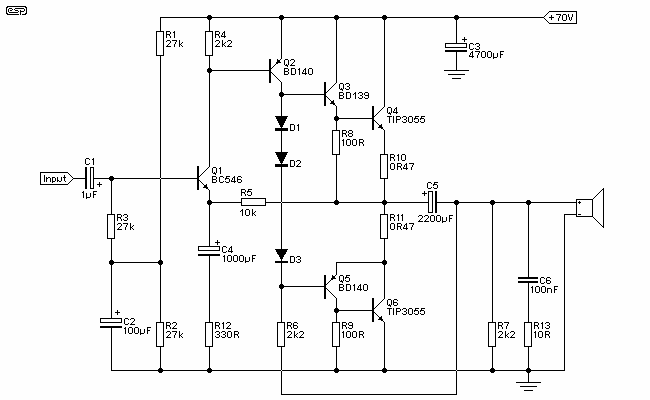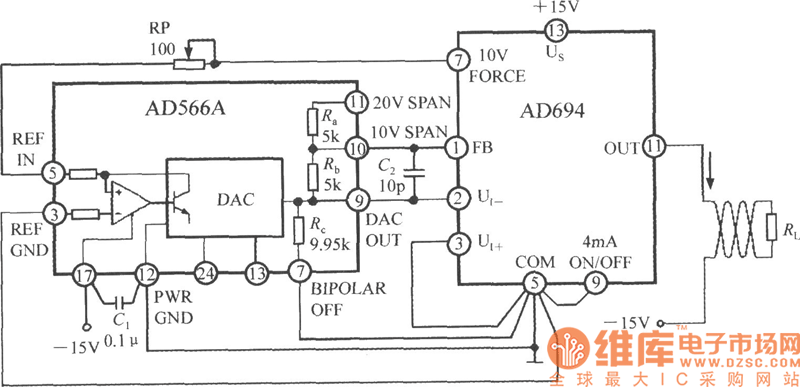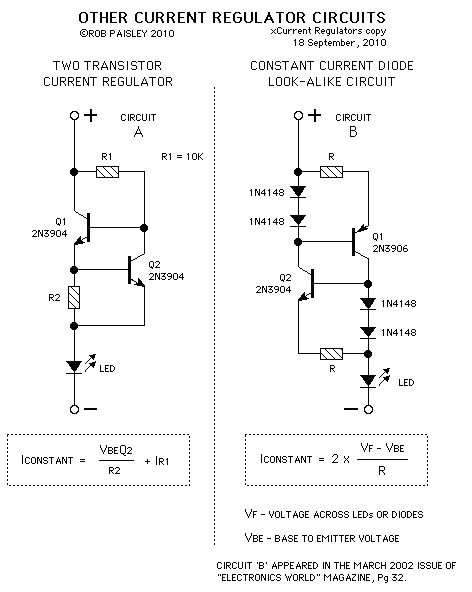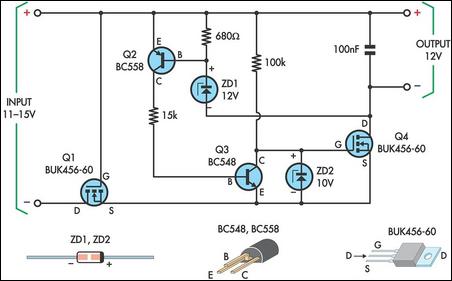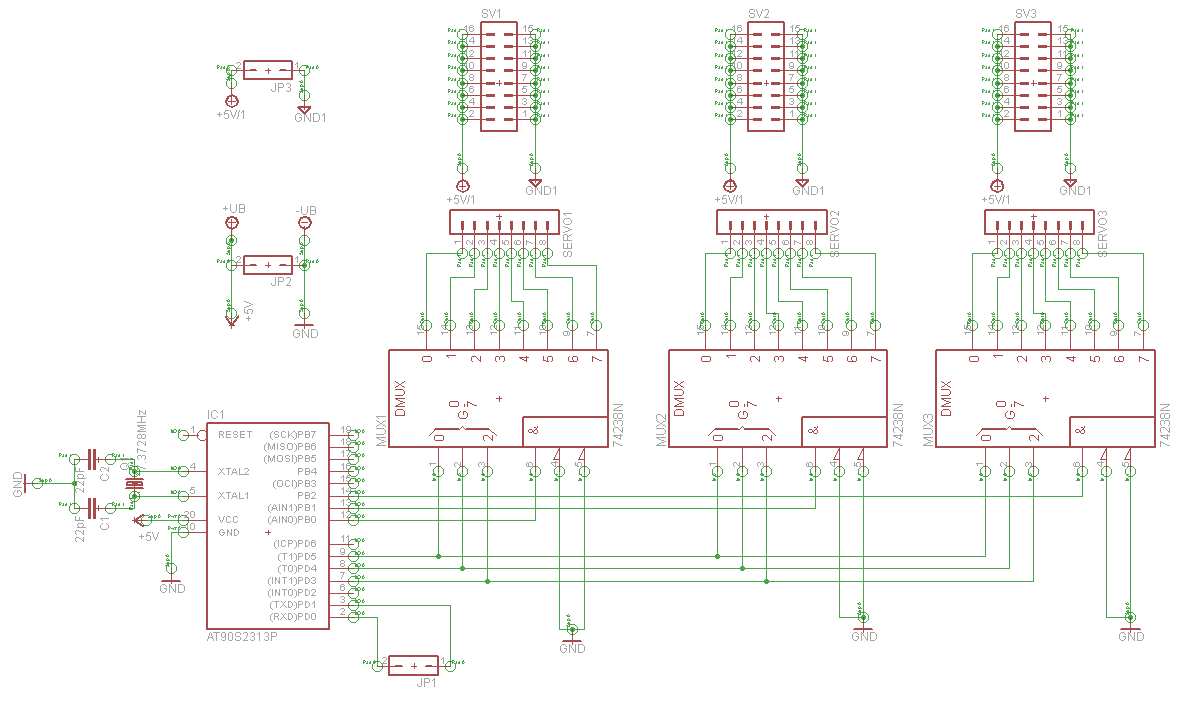
Current Loop
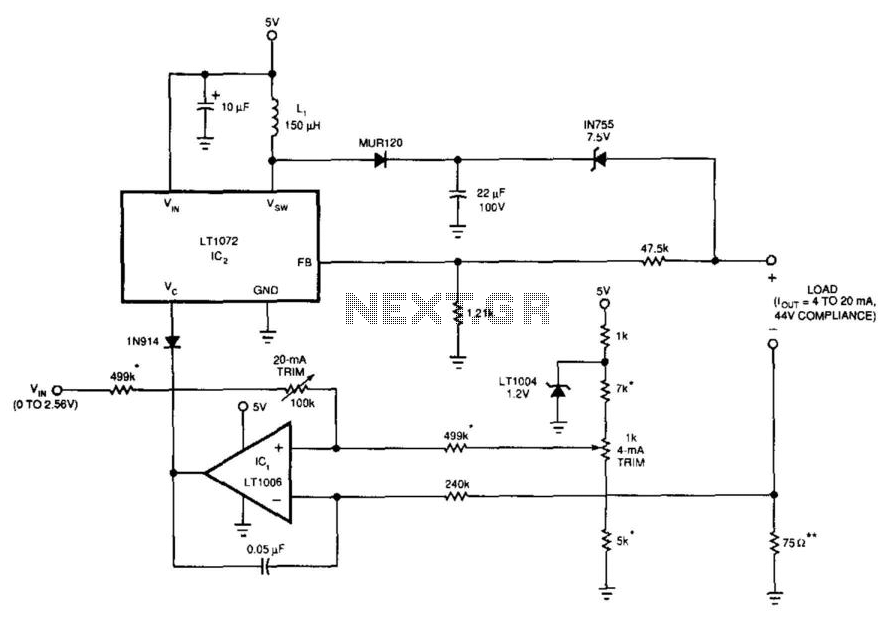
This 5-V circuit employs a servo-controlled DC/DC converter to generate the compliance voltage necessary for current requirements. It is designed to drive 4 to 20 mA into loads as high as 2200 ohms with 44 V of compliance. The circuit features inherent short-circuit protection. A current source, by definition, limits current regardless of the load. The input voltage of the circuit and the 4-mA trim network determine the positive input voltage of IC1. The output of IC1 biases the Vc pin of the LT1072 switching regulator. Resistors connected to the feedback pin (fb) of the regulator prevent the circuit output from exceeding limits in the event of an open load. Typically, IC1 controls the loop; however, if the load opens, IC1 receives no feedback. Under this condition, the FB pin becomes active when it reaches 1.2 V, forcing the loop to close locally around the regulator by activating the internal amplifier of IC2. Consequently, the circuit automatically transitions from a current regulator to a voltage regulator, thus preventing excessive output voltages.
This circuit operates effectively within the specified parameters by utilizing a servo-controlled DC/DC converter that ensures stable compliance voltage. The design is optimized for driving current through resistive loads, making it suitable for applications requiring precise current regulation. The compliance voltage of up to 44 V allows the circuit to accommodate a wide range of load impedances, specifically up to 2200 ohms, while maintaining the desired current output of 4 to 20 mA.
The inclusion of short-circuit protection is a critical feature, safeguarding the circuit from potential damage due to overload conditions. The current source design inherently limits the output current, ensuring that the circuit remains within safe operating limits regardless of the load characteristics.
The interaction between the input voltage and the 4-mA trim network is essential for setting the positive input voltage of IC1. This configuration ensures that the output of IC1 effectively biases the Vc pin of the LT1072, allowing for proper regulation and operation of the switching regulator. The feedback mechanism involving the resistors connected to the fb pin is crucial for maintaining stability in the circuit. It prevents the output voltage from rising uncontrollably in scenarios where the load may become disconnected.
In normal operation, IC1 manages the regulation loop; however, the design anticipates conditions where feedback may be lost, such as an open load. In such cases, the FB pin's activation at 1.2 V triggers a local closure of the regulation loop, engaging the internal amplifier of IC2. This automatic transition from current regulation to voltage regulation is a sophisticated feature that enhances circuit reliability by preventing excessive output voltages that could lead to component failure or damage to connected loads. Overall, this circuit exemplifies effective design principles in electronic regulation, combining functionality with safety measures to ensure robust performance. This 5-V circuit utilizes a servo-controlled dc/dc converter to generate the compliance voltage necessary for loop- current requirements. This circuit will drive 4 to 20 mA into loads as high as 2 200 with 44 V of compliance. It is inherently short-circuit protected. A current source by definition limits current regardless of the load. The circuit"s input voltage and the 4-mA trim network determine ICl"s positive input voltage. ICl"s output biases the LT1072 switching regulator"s Vc pin. The resistors connected to the regulator"s feedback pin, fb, prevent the circuit output from running away in the event that the load opens up. Normally, IC1 controls the loop. However, if the load opens, IC1 receives no feedback. Under this condition, the FB pin becomes active when it equals 1.2 V and forces the loop to close locally around the regulator by activating IC2"s internal amplifier.
Thus, the circuit automatically changes from a current to a voltage regulator, thereby preventing excessive output voltages. 🔗 External reference
This circuit operates effectively within the specified parameters by utilizing a servo-controlled DC/DC converter that ensures stable compliance voltage. The design is optimized for driving current through resistive loads, making it suitable for applications requiring precise current regulation. The compliance voltage of up to 44 V allows the circuit to accommodate a wide range of load impedances, specifically up to 2200 ohms, while maintaining the desired current output of 4 to 20 mA.
The inclusion of short-circuit protection is a critical feature, safeguarding the circuit from potential damage due to overload conditions. The current source design inherently limits the output current, ensuring that the circuit remains within safe operating limits regardless of the load characteristics.
The interaction between the input voltage and the 4-mA trim network is essential for setting the positive input voltage of IC1. This configuration ensures that the output of IC1 effectively biases the Vc pin of the LT1072, allowing for proper regulation and operation of the switching regulator. The feedback mechanism involving the resistors connected to the fb pin is crucial for maintaining stability in the circuit. It prevents the output voltage from rising uncontrollably in scenarios where the load may become disconnected.
In normal operation, IC1 manages the regulation loop; however, the design anticipates conditions where feedback may be lost, such as an open load. In such cases, the FB pin's activation at 1.2 V triggers a local closure of the regulation loop, engaging the internal amplifier of IC2. This automatic transition from current regulation to voltage regulation is a sophisticated feature that enhances circuit reliability by preventing excessive output voltages that could lead to component failure or damage to connected loads. Overall, this circuit exemplifies effective design principles in electronic regulation, combining functionality with safety measures to ensure robust performance. This 5-V circuit utilizes a servo-controlled dc/dc converter to generate the compliance voltage necessary for loop- current requirements. This circuit will drive 4 to 20 mA into loads as high as 2 200 with 44 V of compliance. It is inherently short-circuit protected. A current source by definition limits current regardless of the load. The circuit"s input voltage and the 4-mA trim network determine ICl"s positive input voltage. ICl"s output biases the LT1072 switching regulator"s Vc pin. The resistors connected to the regulator"s feedback pin, fb, prevent the circuit output from running away in the event that the load opens up. Normally, IC1 controls the loop. However, if the load opens, IC1 receives no feedback. Under this condition, the FB pin becomes active when it equals 1.2 V and forces the loop to close locally around the regulator by activating IC2"s internal amplifier.
Thus, the circuit automatically changes from a current to a voltage regulator, thereby preventing excessive output voltages. 🔗 External reference
